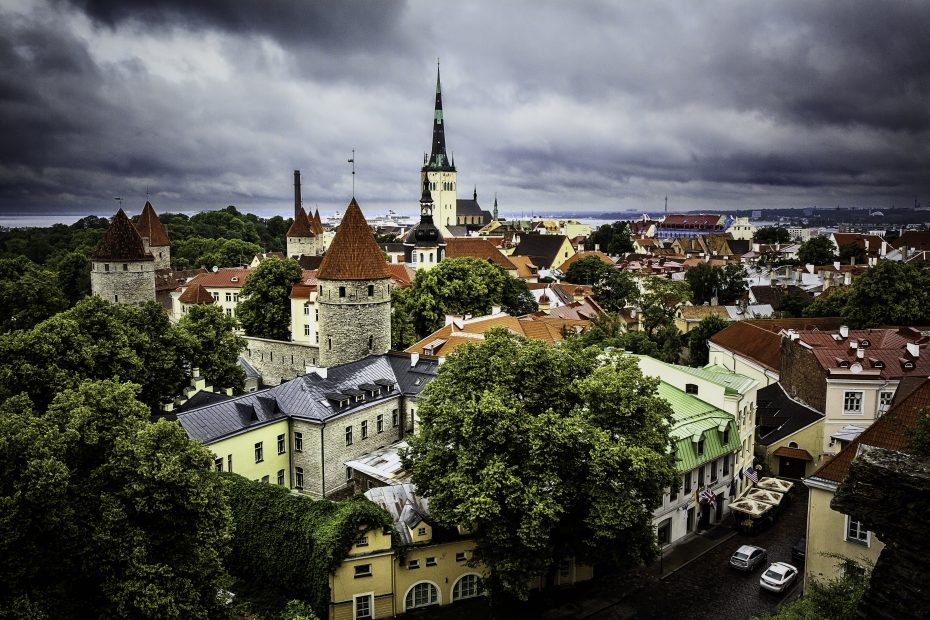Estonia boasts a rich architectural legacy that seamlessly combines medieval splendor with contemporary design. From the fairy-tale Old Town of Tallinn to cutting-edge buildings with Nordic simplicity, the country’s structures showcase both its history and its forward outlook.
The medieval highlights of Estonia transport you back to the days of kings and castles. Tallinn’s Old Town looks like something out of a storybook, with its jumble of gabled houses, Gothic spires, and ancient city walls and towers. Majestic hilltop castles like Toompea and Hermann tower over the landscape. Charming small towns like Tartu and Pärnu still have quaint historic centers with medieval churches and town halls. These architectural remnants provide a window into Estonia’s past.
Yet Estonia is also home to sleek modern icons that reveal its vibrant culture. The KUMU Art Museum in Tallinn wows with its futuristic glass and limestone exterior. The towering National Library resembles a row of books on a shelf. The massive concrete shell of Linnahall Arena makes a sculptural statement on the harbor. These cutting-edge designs exhibit Estonia’s contemporary spirit.
Estonia’s architecture skillfully combines local and foreign influences. Buildings incorporate both Nordic and Baltic styles, from Danish bricks to Polish gables. Local materials like limestone, granite, timber, and iron feature prominently. Designs also incorporate cultural symbolism, like folk motifs and nature themes. This unique blend creates a distinctive Estonian style.
Today, a new generation of acclaimed Estonian architects is making its mark. Pekka Vapaavuori electroplates Contemporary buildings with copper and titanium. Vilen Künnapu’s structures feature radical shapes and complex geometry. Raine Karp elegantly fuses modernism with Estonia’s heritage. These talents lead the way in shaping Estonia’s architectural aesthetic.
Eco-friendliness is another hallmark of Estonian architecture. Green building practices include solar power, smart insulation, and rainwater recycling. Many projects repurpose old structures, like converting a prison into the Viru Hotel. Eco-materials like wood, glass, and clay feature prominently in new sustainable designs. Estonia prioritizes an environmentally responsible approach.
Estonia also revives medieval traditions through contemporary works. The brick Gothic style, with its soaring arches and vaults, makes a comeback in modernized form. Spired towers and arched windows reference Northern Europe’s medieval past while providing modern functionality. By skillfully blending old and new, Estonia links its heritage to its future.
The interplay between past and present creates visually striking contrasts. Centuries-old churches stand alongside futuristic sci-fi creations. Glass skyscrapers loom behind historic stone structures. Rather than clashing, these varied architectural styles coexist harmoniously, representing Estonia’s diversity. This clever juxtaposition is a metaphor for Estonia itself.
With such a rich architectural tapestry, it’s no wonder Estonia has become a popular tourist destination. Visitors flock to admire the medieval Old Town’s gabled roofs and photograph the contemporary KUMU museum’s unusual form. Specialized tours lead architecture buffs to must-see buildings around Tallinn and beyond. For those interested in design, Estonia is a photographic dream come true.
Protecting this heritage remains an important priority. Restoration projects preserve crumbling castles and churches. Strict building codes and zoning laws protect historic districts. Locals and officials alike recognize the importance of maintaining authenticity even as they allow room for modern development. Through careful conservation, Estonia’s architectural treasures will endure.
Estonia will continue to push boundaries with its forward-thinking architecture. The skylines of its cities will keep evolving as new generations of talented designers put their mark on the urban landscape. Global influences, new materials, and fresh ideologies will all shape Estonia’s architectural future. The interplay between old and new is sure to continue as Estonia’s buildings tell the story of its rich past and dynamic present.
In summary, Estonia’s architecture forms a unique tapestry interweaving medieval charm with space-age vision. The conversation between history and modernity occurring across Estonia’s built environment makes the country a captivating destination for design aficionados. Estonia’s sophisticated blend of architectural influences and styles visually encapsulates its multifaceted national identity.
FAQ:
FAQ 1: What is Tallinn’s Old Town known for architecturally?
Tallinn’s Old Town is renowned for its well-preserved medieval architecture, including the town wall and towers, Gothic churches, and gabled merchants’ houses. It provides an exceptionally complete picture of a Northern European medieval city.
FAQ 2: What materials are commonly used in Estonian architecture?
Estonian architects utilize a mix of traditional local materials like stone, brick, timber, and iron alongside contemporary materials like glass, steel, and concrete. This allows them to bridge old and new styles.
FAQ 3: How have Estonia’s historic buildings been preserved?
Estonia uses restoration projects, heritage protection laws, and building codes to preserve its medieval and other historic architecture. Ongoing conservation work helps maintain authenticity.
FAQ 4: How does Estonian architecture incorporate environmental values?
Sustainable features like solar power, smart insulation, rainwater harvesting, adaptive reuse, and eco-friendly building materials are integral parts of Estonian contemporary architecture.
FAQ 5: What architectural styles can you see blended in Estonia?
Estonia skillfully blends Northern European styles like Nordic, Baltic, and brick Gothic with global movements like modernism and futurism, creating a fusion of old and new.
